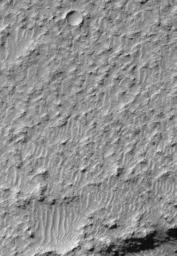Mars exploration in the last half of the 20th Century comes full circle with a modern view of Mariner Crater obtained by the Mars Global Surveyor (MGS) Mars Orbiter Camera (MOC) in early March 1999.
Mariner 4 was the first spacecraft to reach the red planet and take close-up pictures that revealed its ancient, cratered surface. The picture on the left, above, is the 11th image taken by Mariner 4 during its July 1965 flyby. The center of the Mariner 4 image is dominated by a crater that is about 155 kilometers (96 miles) in diameter and located at 32°S latitude and 164°W longitude. The crater was named "Mariner" in 1967 by the International Astronomical Union in honor of its discovery by Mariner 4. The white arrow indicates the location of the new MGS MOC image.
The picture on the right represents an improvement in resolution of almost a factor of 400. It shows a view of a tiny portion of the southeastern floor of Mariner Crater, as it appeared to the MGS MOC in 1999. In 1965, it was a surprise to find that the martian surface is pocked with craters. In 1999, using the MGS MOC, we now have the ability to see objects the size of automobiles on the martian surface. This view of the Mariner Crater floor has a spatial resolution of 1.5 meters (5 feet) per pixel and covers an area only 1.5 km (0.9 mi) wide by 2.2 km (1.4 mi) long. Illumination is from the upper left in both the Mariner and MGS images. For a mercator-projected Viking 1 Orbiter view of this crater (obtained in 1978)click here.
Malin Space Science Systems and the California Institute of Technology built the MOC using spare hardware from the Mars Observer mission. MSSS operates the camera from its facilities in San Diego, CA. The Jet Propulsion Laboratory's Mars Surveyor Operations Project operates the Mars Global Surveyor spacecraft with its industrial partner, Lockheed Martin Astronautics, from facilities in Pasadena, CA and Denver, CO.

 Planetary Data System
Planetary Data System












